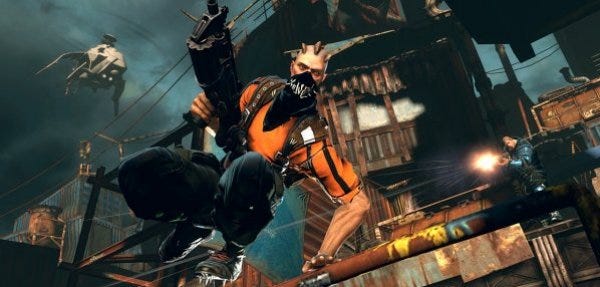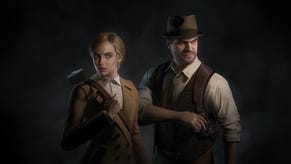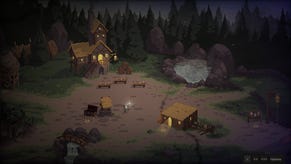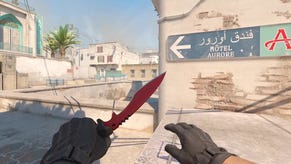Disposable Worlds And Imagining Brink 2
Playing Brink this weekend made me worry. But not about the usual things. I was worried that there would never be another way to experience the details of its world - no possibility for further exploration of the Ark and its precarious situation. This isn't something I normally think about when faced with a multiplayer shooter. I certainly had no interest in finding out more about the world of Quake III, or Battlefield 2, because nothing in them really inferred anything outside those isolated battlegrounds. Their conflicts were their world entire. Not so with Brink, and, now that I come to think of it, a few other worlds, too. I begin to wonder whether game fictions might be too readily disposable.
Brink's world design is its strongest asset. The fiction, that of a failed utopian floating city of the near future, is refreshingly clever, and it is delivered quite elegantly within shades-of-grey politics and gorgeous flourishes of human interest. Remarkably, for a shooter, there is no true good or evil, just desperation and need fuelling intense conflict. The spectre of The Real Problems Of Modernity haunts its speculative shooterisms in a way that most game fictions barely bother to think about. What a shame, then, that all this was for a multiplayer combat game, where the story will become invisible via repetition. It's unlikely that we will ever be given tools for exploring this world in any other way. Games like this don't tend to coin universes. No Mass Effect equivalent will be set in the halls and slums of the Ark.
But it should be.
World-building is a strange art, and the impulse to expand worlds beyond the original remit is a peculiar one. The other thing I spent quite a bit of time doing over the weekend was reading about the Dune universe, because I had only ever read the original books and was unaware of how it had been carefully expanded by Herbert's own fans and progeny. It was as if they felt that it was too precious an invention to leave unfinished (as if any such work could be finished), and that it should be pushed to its limits for the sake of all those who enjoyed it. I have to admit I found that impulse a little distasteful, not least because Herbert's own vision was so singular and esoteric. The expanded stories seem (on the surface) somehow less artful, and perhaps without the same stylistic flair. The same is often true of overly expanded game universes, of course, with the derivative works never having quite the same flavour as the original blast of ideas. That doesn't mean I'm not prone to wanting more from a favoured universe: I'll take all the STALKER I can eat.
How a universe is delivered and then consumed ends up defining how it is expanded. Take Mirror's Edge. Often lauded for its visual design, I felt that the way the world was used within the game was actually something of a waste, and unlikely to inspire the kind of imaginative investment that players put into other worlds, thus demanding further world building. A better design, I felt, would have been to create a series of rooftop environments that you might have learned and repeatedly used, and a world you might have got to know better. Once familiar with these environments you'd find the best ways back and forth across them, using your actual skill as a runner to outwit the police. This, of course, is partly how the trials worked, which showed that the developers had created a world without fully realising how best to put it to use. (Not to mention the art-budget reduction of re-using assets over and over!) If Mirror's Edge had used its world a little differently, I feel, we might have gotten a sequel, and a world, too.

Of course Brink is going to benefit from being a game where the same maps are used over and over, but in this case it's to the detriment of an inventive fiction. What we see of the Ark is tantalisingly close, and yet out of reach. You're in the world, but not really of it. Imagine the same gorgeous, clever scenario as a setting for an RPG, or even a linear shooter: something that allowed you to get to grips with the flavour of the world a little better. And perhaps that is what should be happening. Create the best world you can, game designers, and then use that to host quite different games. (Borderlands seems like an example of that sort of thing – a hub game into which different experiences were plugged for multiplayer and so forth. It didn't actually have racing game DLC to expand its vehicular elements, but it quite easily could have done.) I expect to see this sort of thing happening more and more as game studios try to curb their spiralling asset-creation costs.
There was a lovely comment by someone in the recent Aion thread, which suggested that NCSoft should just use all the assets to create a single-player game. I couldn't agree more. Just give me that world to wander around, fight a few monsters, and I'll take a look. Trap me within the systemic corridors of an MMO level structure, and I won't give it a second glance. The same is true for many other game worlds that will be lost to time. Codemasters' racing game FUEL was a good example. I only hope someone realises what they had there and ends up building something more tangible with it than the lightweight racing game that was give to us.
I supposed what I am fishing for is the idea that Brink's world should not vanish with this game as so many other game worlds have. I'm saying that it should get a sequel to the fiction, if not the game – something that allows us to explore its world through other game mechanics, rather than mission bookends and (splendidly acted) cutscenes. If Bethesda and Splash Damage have a “where now” for this game then I hope that they realise that the world is their strongest asset, and they need to let us loose in it.
Ideas are cheap, but that doesn't mean game worlds should be disposable.









